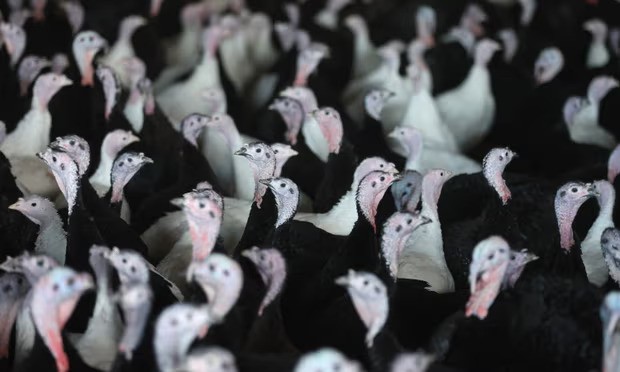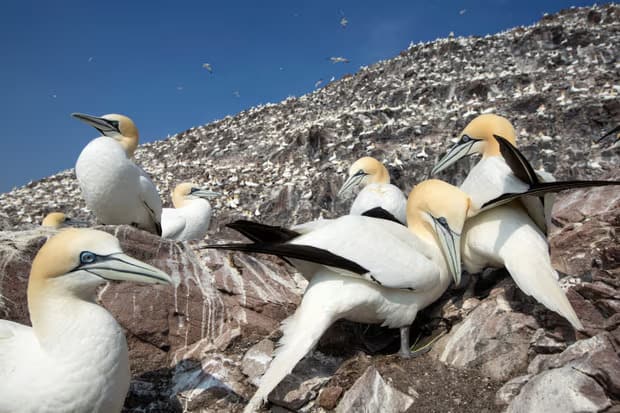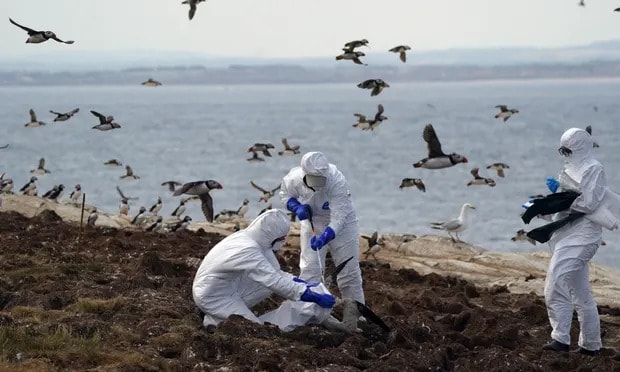Some birds have developed immunity to avian flu, according to scientists who say there are “encouraging signs” that the deadly virus could kill fewer birds this winter.
The current H5N1 bird flu outbreak, which started in 2021, has been the worst recorded, and is thought to have killed millions of wild birds. Mortality rates appeared to be very high among wild birds, but it was not known how many survived and gained immunity.
Preliminary research by a consortium of scientists has confirmed that two populations of seabirds now have immunity. They took blood samples of northern gannets on Scotland’s Bass Rock – which were hit hard by avian flu in 2022 – and found that 30% of them had antibodies.
Britain is home to two-thirds of the world’s northern gannets, and ornithologists are particularly concerned about the species – Bass Rock is the world’s largest colony. The researchers also tested shags, and found that about half had immunity.
“This is the first evidence [of immunity] in seabirds,” said Prof Ian Brown, head of virology at the Animal and Plant Health Agency (APHA). “It is giving us insights into populations that we have never seen exposed to this virus before.”
The research was done by the FluMap consortium, which is led by the APHA, and their key findings have been published in Ibis, the International Journal of Avian Science.

The sample size was small: about 30 birds for each population. Brown said it was extremely challenging catching wild birds and taking blood samples (which is partly why it has not been done before). But the findings support observations from conservationists that some birds appear to have acquired immunity – notably gannets, whose typically blue irises turned black after surviving infection.
It is not known how long immunity will last, as avian flu changes quickly, or what percentage of birds survived getting the disease initially. Seabird populations are slow to recover because they typically only have one or two offspring a year, so there are still concerns about long-term impacts.
Researchers now want to test other wild birds, especially those living on farms, to find out more about how the virus is getting into poultry sheds. The virus can travel only short distances – less than 10 metres, researchers say – so is unlikely to be spread through airborne transmission between farms. This suggests transmission is mostly via wild birds.
Researchers are now watching anxiously to see what happens this winter. October is a month of uncertainty due to the influx of migratory birds and the possible new variants they might bring with them.
Between 1 October and 28 October 2022, there were 58 confirmed cases in poultry in Britain. This year, there have so far been none in October. Globally, there are very few poultry cases in northern Europe, and a handful in wild birds. “If you compare that to the same period last year, it is quite different,” said Brown.
He added: “We’re in a very uncertain window at the moment, and we won’t be advocating any dropping of biosecurity standards. Far from it, because this is a very unpredictable virus and an unpredictable disease. But at the moment, they’re encouraging signs.”
The H5N1 virus has multiple genes that can switch and evolve together to spread the virus quickly into a wide range of species. When the latest outbreak started, it was because changes to the virus made it much deadlier and more transmissible. Recent changes in the dominant strain of H5N1 in the UK suggest it could now be changing to become less virulent.
This new finding follows research published in Nature that shows the centre of bird flu outbreaks has shifted from Asia to Europe and Africa. There are still concerns about it reaching new parts of the world, particularly Antarctica, as wild populations migrate from South America.
What you can do
Support ‘Fighting for Wildlife’ by donating as little as $1 – It only takes a minute. Thank you.
Fighting for Wildlife supports approved wildlife conservation organizations, which spend at least 80 percent of the money they raise on actual fieldwork, rather than administration and fundraising. When making a donation you can designate for which type of initiative it should be used – wildlife, oceans, forests or climate.
This article by Phoebe Weston was first published by The Guardian on 20 October 2023. Lead Image: Gannets on Bass Rock, off North Berwick. The world’s largest colony of northern gannets was hard hit by bird flu last year but 30% now have immunity. Photograph: Murdo MacLeod/Guardian.







Leave a Reply